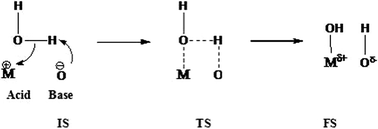Oxygen-assisted water partial dissociation on copper: a model study†
Abstract
It is essential to understand and control the O–H bond cleavage on metal surfaces with pre-adsorbed oxygen atoms in heterogeneous catalytic processes. The adsorption and dissociation of water on clean and oxygen-pre-adsorbed copper surfaces, including Cu(111), Cu(110), Cu(100), Cu(210), Cu(211), Cu(310) and Cu(110)-(1 × 2), as well as Cu-ad-row and Cu-ad-atom, have been investigated by the density functional theory-generalized gradient approximation (DFT-GGA) method. The calculation results indicate that the presence of oxygen species significantly promotes the water dissociation. It is found that the promotion effect depends both on the adsorption energy of the pre-adsorbed oxygen and the distance between the pre-adsorbed oxygen and the stripped hydrogen in water: the more strongly the oxygen atom binds to the metal surface, the less the promotion effect it has on the water O–H bond cleavage; the shorter the distance between pre-adsorbed oxygen and hydrogen in water, the greater is the promotion effect. Based on electronic analysis, physical origin of the promotion effect can be attributed to the strong interaction of acid–base pair sites on oxygen–metal systems.


 Please wait while we load your content...
Please wait while we load your content...